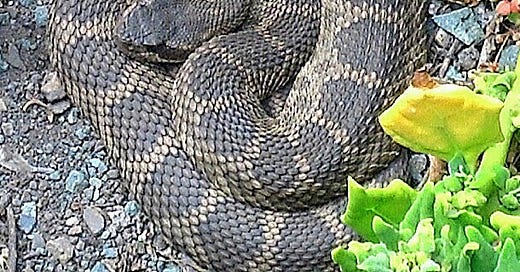Many years ago, while working with 6th graders during a field trip at a State Park Picnic Area, we heard a terrified scream coming from behind the door of the outhouse. It turns out a snake had crawled under the outhouse door and was now between a student and her freedom. It really is remarkable how long and loud a little girl can scream. After managing to get the door open, we saw the girl perched on the top of the toilet, pointing a trembling finger towards the offender. There, coiled up in the corner, was a skinny, 6-inch garter snake whose jawbones were probably aching from the high-frequency screams being emitted. After picking the snake up, I tried to show the student how harmless the poor little creature was, but she was having none of it and ran off.
Over the years, many polls have revealed that Americans are more terrified of snakes than any other animal, spiders run a close second. Many times, those fears are tied to cultural and family traditions or fears. Or perhaps it’s popular media’s representations of snakes with fangs and venom. California is home to 46 species of snakes, but only 6 contain venom. Of course, these snakes should rightfully be given their space and respected.
Here on our coast, we are lucky in a couple of ways. We only have one venomous snake, the Northern Pacific Rattlesnake, and the ones along our coastal plain are some of the mellowest rattlesnakes you will ever encounter.
I’ve worked in Montana de Oro for over 35 years and see numerous rattlesnakes every year. I can count on one hand how many times encounters with these lovely creatures were aggressive. The vast majority of rattlesnakes in Montana de Oro are the epitome of the laid-back, coastal Californian. There’ve been times when they were coiled up along the side of the trail, remaining motionless until they realized 20 kids were looking at it and snapping pictures. Then they would slowly slide off into the brush or down a nearby hole, not even buzzing their tail. A far different response than I’ve received from Western Diamondbacks in the Mojave Desert.
Rattlesnakes are beautiful, fascinating creatures with unique traits. Males can have some of the highest testosterone levels of any animal and like lizards they have two penises, called hemipenes, one for each teste. In humans and most other mammals, sperm from both testes is mixed prior to mating, so males from those animals have just one chance to inseminate before they need a “refractory period” to recharge (you know what I mean, guys, right?). A snake (or lizard), on the other hand, can mate with one female and then use his other hemipene for another female soon after if the opportunity arises.
The females also have some surprises in their physiology. Females can store the male’s sperm in their bodies for up to 8 years and then give live birth, sometimes from several different males. Some females have even been observed to have given birth asexually! Once born, the females are very caring mothers working with other females to care for their young in “nurseries” for about 10 days until the babies undergo their first shed, then go off on their own.
Perhaps I’ve given you a different perspective on our scaly friends, and if you’re walking along hoping to see one of these striking creatures, keep your eyes open along the sides of the trails or near holes, rocks, or logs. I tend to see them on the coast most often on overcast days in the summer rather than sunny ones. Being ectotherms, they rely on their surroundings to manage their body temperature. The combination of warm ground with a cloudy sky is perfect snake weather!
Just Around the Corner is the Live Oak Music Festival! June 13 - 15
I always look forward to this Father’s Day Weekend event, and this year I have been asked to be the featured storyteller for the children’s stage. If you happen to be there, come check it out on Friday and Saturday afternoons at 2 pm. It should be a good time!





